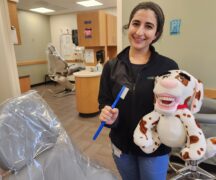By JAN LARSON McLAUGHLIN
BG Independent News
Tyler Briggs doesn’t want to make people squeamish. But it comes with the job.
As an epidemiologist at the Wood County Health Department, Briggs is often pointing out how infectious diseases occur. That is sometimes accompanied by psychosomatic symptoms.
“When you talk about head lice, your head itches,” he said.
And when Briggs uses an image of a poppyseed muffin to show the miniscule size of ticks, it inevitably curtails appetites.
“That poppyseed photo ruins them for people,” he said of the unintended consequence.
Briggs advised that people who believe they have some type of infectious disease should consult an expert – preferably human.
“I would caution them against Googling it,” he said. And under no circumstances would he recommend going to “Iwaspoisoned.com” – unless for curiosity sake.
Briggs admitted that being an epidemiologist does make him more aware than the average person of the infectious disease risks that exist. It has become a work hazard.
“I’m a very health conscious person already,” he said. “This job has definitely ruined some things for me.” For example, at the gym, Briggs wipes down the equipment before and after he uses it.
Briggs, who has been with Wood County Health Department for a little more than one year, chose epidemiology as a career since it comes with a guarantee of constant learning.
“I like science. I like math, and I like health,” he said. “For me, this is where those fields intersected. It fit well with my passion.”
The job varies from day to day, from investigating a foodborne outbreak, to studying cancer profiles of counties, to educating the public on how to prevent infectious diseases.
“It’s always interesting to see the different mechanisms of the way people get sick,” Briggs said.
Every once in awhile, this region will see a case of unusual illnesses – like Legionnaires Disease.
“I like it when we see things we don’t typically see,” he said.
“I enjoy my job, but I never hope for anything bad. When I’m busy, that means somebody else is sick,” Briggs said.
One of the newer health issues involves drug-resistant organisms. The bacteria are resistant to many antibiotics, making the diseases potentially life threatening.
The U.S. does not have many of the more exotic diseases, and frightening new ones like fleshing eating bacteria are extremely rare.
“For the most part, the greater U.S. is pretty safe,” Briggs said.
The most common infectious diseases seen in Wood County are sexually transmitted diseases – with Chlamydia being the most frequent, averaging 450 cases annually. And contrary to popular belief, the high number of STDs aren’t just seen among college students.
“It’s a common misconception,” Briggs said.
There is always work to be done, “even when our disease quota is getting a little low,” he said.
Public education is important when it comes to avoiding contagious diseases. Hygiene habits play a big role, Briggs said.
“People really underestimate that,” he said of the value of simple acts like handwashing. “Prevention should be a huge step, and for some reason it takes a backseat, and I don’t know why,”
Also very important are vaccinations.
“That’s something I wish the public knew more about,” he said.
Wood County’s level of compliance with vaccinations is “fairly good,” Briggs said. Ohio allows immunizations to be avoided for philosophical, religious and medicinal reasons. But he stressed, “Wood County is pretty good” about getting shots.
Briggs’ job requires that he provides education at facilities where disease outbreaks have occurred, such as nursing homes, schools, banquet halls or catered events.
As public health staff investigates outbreaks, they often encounter “recall bias,” he said.
“That’s my biggest obstacle,” he said, explaining that many people have difficulty remembering possible exposure to diseases. That is especially true in the cases of diseases like Hepatitis that can be dormant for 40 days.
Oftentimes, it is impossible to pinpoint the exact cause of outbreaks, Briggs said.
“For the most part, we are making an educated guess,” he said.





